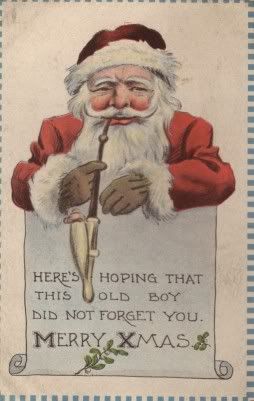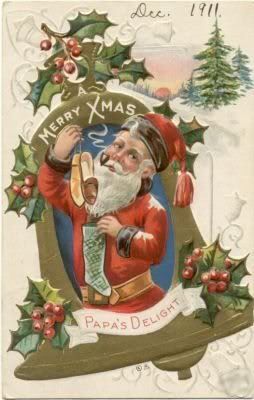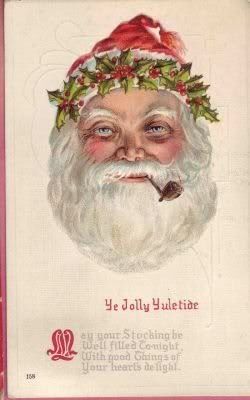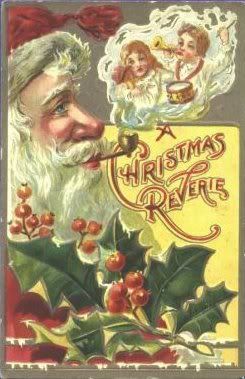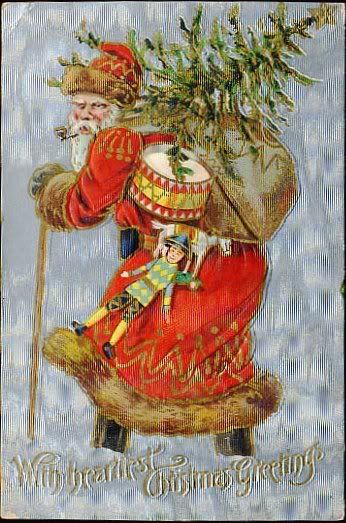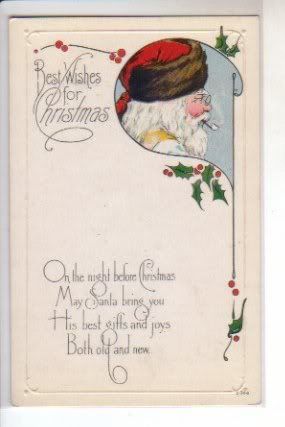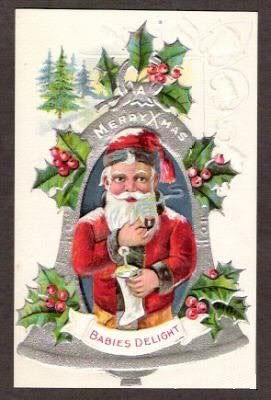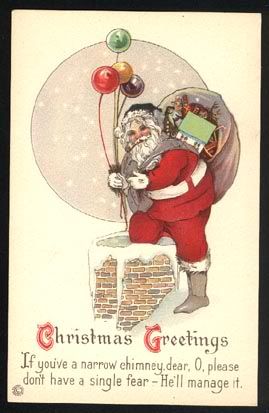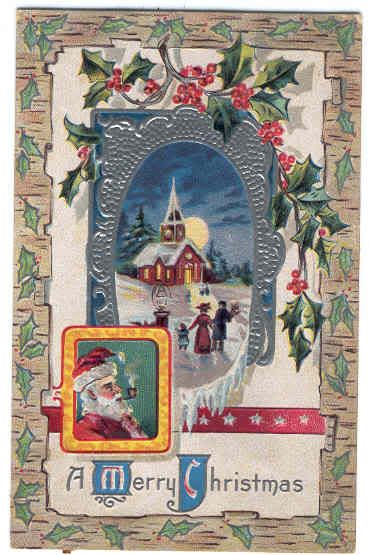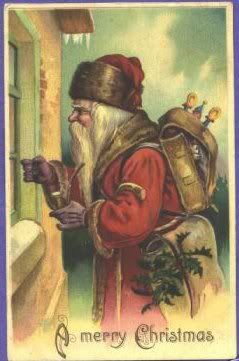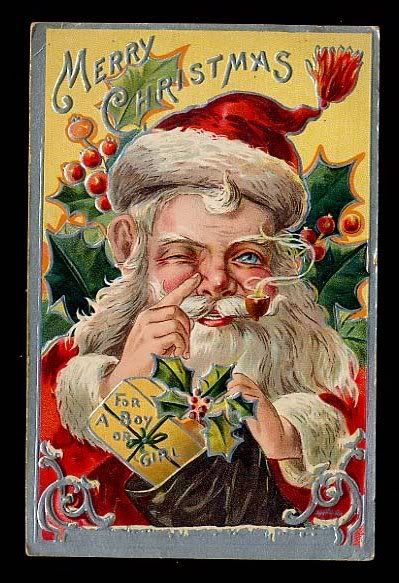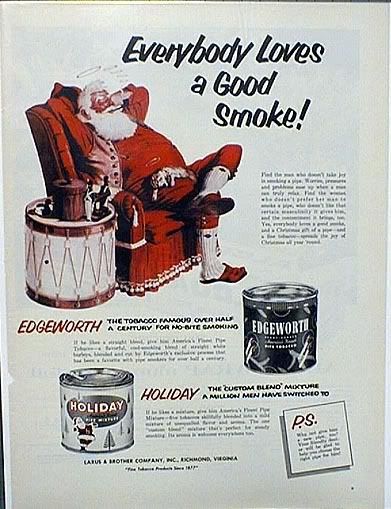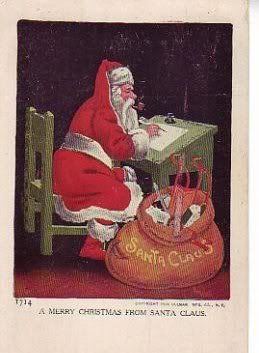I did a long-overdue pipe cleaning today. I didn't clean every pipe that needed it, but I did clean up four pipes that were badly in need of a cleaning and reaming: the Wellington, the Kaywoodie author, the Velani Dublin and the Velani octagon. These four pipes have been getting most of the work lately, and the Wellington especially needed a good cleaning because the reservoir gets gunked up pretty bad. I use a q-tip soaked in Everclear to clean it out.
I did this cleaning today because yesterday my tobacco order came in: one pound each of Bayou Night and Gray Ghost, both from Cornell & Diehl. These two blends have been my favorite smokes for a long time, although they are very different. Bayou Night is a Perique blend that has a lot of Perique; Gray Ghost is a blend of Virginia and maduro cigar leaf. One thing they have in common is that they are both quite robust. I have really been missing the little "sting" in my nose from the Gray Ghost. I have just finished a bowl in the author and am about to load it up again. Yes, I sometimes smoke the same pipe twice in a row without cooling it. Some pipes are up to such use, and some are not. I have done this with several of my pipes and so far I have not caused the downfall of civilization, so I don't worry about it too much. Since the author has a screw-in stem, I just unscrew it, give it a cursory clean, and keep going.
The Wellington and the Velani Dublin have been my truck pipes for a good while now, in fact I consider the Wellington to be on permanent station in my truck since it has become sort of my "signature" pipe. I carry pipe cleaners and a little Everclear in an old pipe sweetener container in my truck so I can give them light cleanings between smokes. I brought them inside today because they both needed a good reaming. The cake was getting a little too thick; somewhere on the heavy side of a nickel's thickness, I'd say.
I also made a long-overdue update to my online tobacco cellar, and finally put a permanent link to it in the sidebar, if you care to see what I have on hand. I will try to keep it more current during the coming year, and update it at least once per month.
Sunday, December 28, 2008
Thursday, December 25, 2008
Wednesday, December 24, 2008
Tuesday, December 23, 2008
Monday, December 22, 2008
Sunday, December 21, 2008
Saturday, December 20, 2008
It's a pipe

The Chokwe peoples occupy the broad expanse of open savanna in present-day Angola and Democratic Republic of Congo. During the eighteenth and nineteenth centuries, Chokwe chiefs became increasingly involved in trade with Europeans who sought rubber, wax, and ivory as well as African slaves for their colonies in the New World. Slaves were often exchanged for firearms, and these were employed in raids on neighboring peoples that produced more captives to sell to European traders. Local leaders who prospered from this exchange frequently commissioned prestige items from local artisans to indicate their wealth and power. This tobacco pipe is one such item that demonstrates the degree to which warfare, the slave trade, and elite arts were intertwined at this time. The pipe itself was the prerogative of individuals who could afford expensive imported tobacco, generally by trading slaves, while the rifle refers to the means by which such slaves were acquired.Read the whole article here.
via Olivier at My Pipes Community
Friday, December 19, 2008
Thursday, December 18, 2008
Wednesday, December 17, 2008
Vintage Christmas Ad (1955): Kaywoodie Pipes
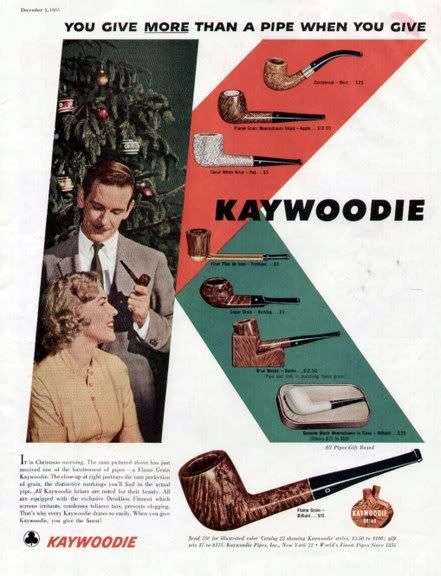
One of the few ads I have that pictures a white briar (third from top). During WWII, Kaywoodie had more than enough good briar warehoused to last for a long time, and they made a big deal out of it in their ads. They also were sure to create the "IMPORTED BRIAR" stamp on their pipes, which others began imitating--and still do, although now it's pretty much irrelevant (as I mentioned previously).
White briar was supposed to have the look of meerschaum and the feel of briar. In my opinion, it really has neither. White meerschaum is a soft, creamy kind of white. The Kaywoodie white briar was just briar with a special finish applied that they invented. It was bright and glossy and entirely unlike the appearance of meerschaum. Also, the finish was only skin deep, and if the pipe accidentally got scuffed or scratched too hard, the natural color of the briar would of course show through the scuff. It doesn't have the feel of briar because of that slick glossy finish. I had one once, smoked it a little, then cleaned it up nice and sold it.
Top to bottom in this ad, we have a Chesterfield (Kaywoodie's knock-off of the Peterson System pipe) billiard, a top-o-da-line Flame Grain apple with a completely gratuitous and unnecessary meerschaum lining (another gimmick), the aforementioned white briar billiard or possibly pot--hard to tell--with a rustic finish that you would probably never see on a real meerschaum, one of those Falcon knock-offs with an aluminum stem and a threaded bowl (change bowl shapes at your whim), a nice Super Grain bulldog, a straight Dublin with its own briar pipe rest (nice), a real meerschaum, and at the bottom another top-o-da-line Flame Grain without some silly insert.
Tuesday, December 16, 2008
Monday, December 15, 2008
Sunday, December 14, 2008
Saturday, December 13, 2008
Friday, December 12, 2008
Thursday, December 11, 2008
Wednesday, December 10, 2008
Vintage Christmas Ad (1964): Give him a Kaywoodie
Tuesday, December 9, 2008
Monday, December 8, 2008
Sunday, December 7, 2008
Saturday, December 6, 2008
Friday, December 5, 2008
Thursday, December 4, 2008
Wednesday, December 3, 2008
Santa Smokes a Pipe #3 (1906)
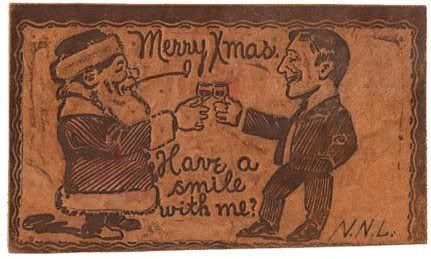
A leather postcard. What a wonderful way to offend nannyist anti-smokers and PETA goons both at the same time.
Tuesday, December 2, 2008
Monday, December 1, 2008
Santa Smokes a Pipe #1 (1901)
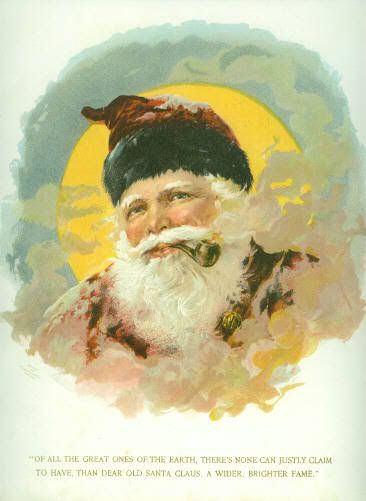
NOTE: I first posted this series two years ago, in December of 2006, on another blog. I have seen nothing to make me change my original statements.
*****
Modern political correctness and rampant nannyism are revising history. Many contemporary renditions of Santa Claus have removed the pipe. I'm sure it's only a matter of time before someone re-writes "The Night Before Christmas" to remove the stump of a pipe clenched tight in his teeth.Today and continuing through Christmas Day I will be posting a series of old portrayals of Santa Claus, one each day. No (or at least, minimal) commentary, just pictures.
The first item up is from 1901.
Saturday, November 29, 2008
Pipe superstitions
A superstition specific to pipe smoking warns that a pipe should never be lit from a burning lamp or candle, which, according to the French, will provoke a wife to argumentativeness, and possibly even infidelity. Blowing smoke rings is, however, a good omen said to promote the luck of both the smoker and those in the immediate vicinity. Among American Indians, smoking a pipe of peace is an important social ritual and no one must refuse to take a puff if the pipe is offered to them. The ceremony must be done in total silence--if anyone speaks, the pipe must be dropped at once. Disaster will befall anyone who attempts to smoke from it again.Just a little something from email inbox, thanks to Brer.--from Cassell's Dictionary of Superstitions by David Pickering
Featured Pipe Smoker (Art): Alchemist by Adriaen van Ostade
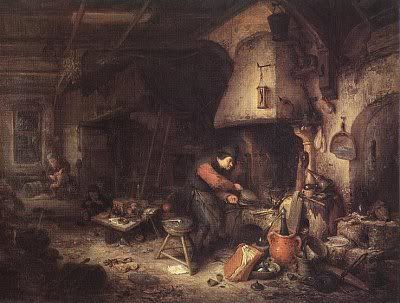
Alchemist by Adriaen van Ostade (1610-1685)
In this painting by Dutch painter Adriaen van Ostade, an alchemist tends his fire surrounded by his accoutrements and equipment. His clay pipe and spectacles lie on the stool behind him. Bad place, if you ask me. If he absent-mindedly sits down he'll break his pipe and his glasses at the same time.
Van Ostade was born Adriaen Hendricx in the town of Ostade, Holland. He adopted the name "van Ostade" as a painter, as did his brother Isaack. He was a Baroque-era artist who was influenced by Rembrandt. One source says he created 385 paintings, another source states that it was really more than 900. In any case, he was very prolific. Most of his works portrayed homely scenes such as taverns, village fairs, and various country settings.
Adriaen van Ostade links at Wikipedia and Artcyclopedia.
NOTE: There will be no further Featured Pipe Smokers for the month of December, because of a special series of illustrations I have lined up to run through Christmas. The regular weekly Featured Pipe Smoker will return in January.
Wednesday, November 26, 2008
Vintage Ad (1943): "I Smoke a Kaywoodie"

As I mentioned before, Kaywoodie made a big selling point out of advertising their use of real Mediterranean briar, because they had large stockpiles of it and during the war there was no way to import more. Some other U.S. pipe makers ran out and tried to use American briar, which is not fit for pipes by any means.
Based on inflation, the pipe above would cost $140 right now. That was a lot of money to be shelling out for a pipe in 1943. An expensive pipe like this was certainly at least a Prime Grain, but more likely was a Flame Grain (both high-end Kaywoodie grades). With wood of this quality, the meerschaum insert is only a sales gimmick--it wouldn't improve the smoking qualities at all, except in that the usual cake build-up would be neither necessary nor even desired.
During this era, Kaywoodie stopped using a white cloverleaf logo and instead used a white circle with a black cloverleaf outline in the center of it. The logo could be either on the top or side of the stem.
Saturday, November 22, 2008
Featured Pipe Smoker: Aaron Spelling

Aaron Spelling (1923-2006)
Born in Dallas, Texas, Aaron Spelling served in the Air Force (at that time I think it was known as the Army Air Corps) before attending Southern Methodist University in Dallas and graduating in 1949 with a Bachelor of Arts degree.
His first foray into showbiz was as an actor, with a small part in the movie Vicki in 1953. He also acted in several movies and TV shows, such as I Love Lucy, Gunsmoke, and Alfred Hitchcock Presents. However, his success came in writing and producing. His first work at producing was for Zane Grey Theater in 1957. He continued to produce TV shows prolificly from then on, and was the producer for such notable series as The Mod Squad (1968), S.W.A.T. (1975), Starsky and Hutch (1975), The Rookies (1975), Family (1976), Charlie's Angels (1976), Fantasy Island (1977), The Love Boat (1977), Hart to Hart (1979), Dynasty (1981), T.J. Hooker (1982), and Melrose Place (1992), plus a lot of others.
His huge mansion was considered by some outrageously extravagant even by Hollywood standards, and is supposedly the largest single-family dwelling in California. He has a place in the Guinness Book of World Records as the most prolific television producer. He is listed as producing over 200 TV shows by imdb.com.
His children Tori Spelling and Randy Spelling are both actors.
He was said to have been a lifelong smoker until he was diagnosed with oral cancer in 2001. He suffered a stroke on June 18, 2006 and died from complications related to the stroke five days later on June 23.
Wednesday, November 19, 2008
Vintage Ad (1972): Ronson Pipes
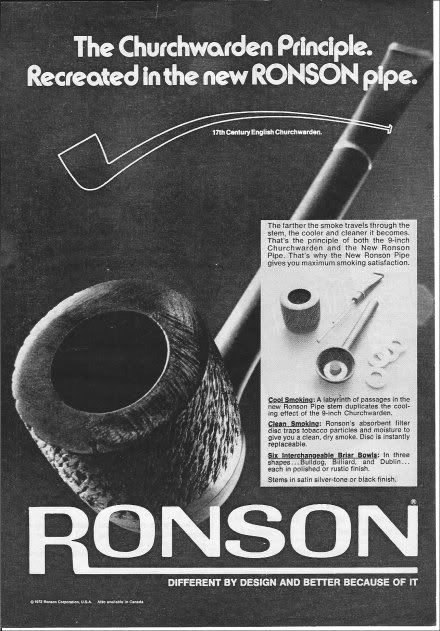
So it appears that Ronson, now known primarily for its lighter fluid and little else, once made and sold pipes. This is another gimmick pipe in the pattern of the Falcon, by which I mean it had a metal body with interchangeable screw-on briar bowls. The only Falcon I ever had didn't use any filters, however.
But the real gimmick here is the "labyrinth of passages" in the stem which were supposed to duplicate the length of a nine-inch churchwarden and thereby produce a cooler smoker. Did it really work? I have no way of knowing, but I'd guess it's more gimmick than real effect. The metal rod attachment that's part of the bit looks very much like the Kirsten design, so I don't know exactly how the "labyrinth" worked, but anything with a "labyrinth of passages" in the stem sounds to me like it would be very difficult to clean. Although I suppose it could be cleaned pretty well using a pipe retort.
Saturday, November 15, 2008
Featured Pipe Smoker (Art): Shoshone Warrior with Pipe by Alfred Miller

Shoshone Warrior with Pipe by Alfred Jacob Miller
Not a person, but a painting of someone whose name is apparently lost to history. According to the book I scanned this from, the artist said the warrior's pipe was "the great solace of his leisure hours."
As for the artist, Alfred Jacob Miller (1810-1874) was born in Baltimore, and it is written that he was the first artist of his generation to explore the American West. He accompanied an expedition led by Sir William Drummond Stewart in 1837, following a route that later became known as the Oregon Trail. He witnessed one of the fur trappers' annual rendezvous on the Green River in what is now Wyoming.
After the expedition, he returned to his home town of Baltimore, where he remained until his death, creating many works of art based on the sights he had seen during his journey into the west. Few people knew of his works during his lifetime, and it wasn't until after his death that his art came to the attention of the general public.
An entry on Miller with many links leading to online exhibitions of his work can be found at artcyclopedia.
The pipe in the portrait is made of a wooden (or perhaps, cane or reed) stem with the bowl undoubtedly carved from the rock known as pipestone or Catlinite.
Wednesday, November 12, 2008
Vintage Ad (1946): Van Roy
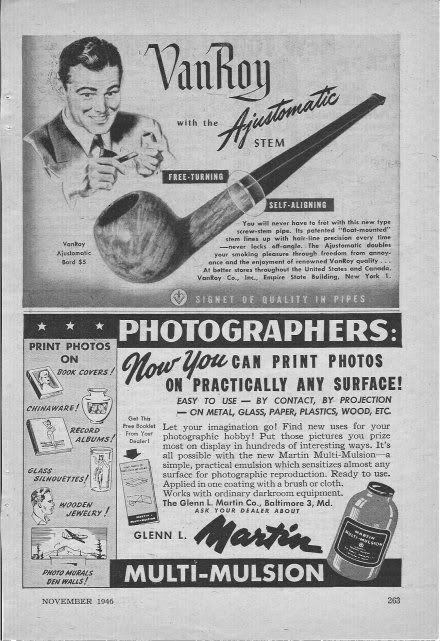
Kaywoodies were famous (or infamous, to some) for their screw-in stems. However, they had a problem of eventually getting off-center because of the very slight wear to the fitment threads every time the stem was removed and replaced. Kaywoodie tried to fix this by making each pipe with a slightly off-center rightward cant. That is, if you held the new pipe in your mouth, the bowl would cant slightly to the right. As time went by, it would eventually line up dead center. Of course, as even more time went by, it would begin slanting slightly leftward due to continuing thread wear.
So Dr. Grabow (also famous or infamous, depending) came up with the "Ajustomatic" screw-in stem. Similar to Kaywoodie's, except that the screw-in fitment wasn't fixed as tightly and permanently into the stem. That way one could use just a little extra force to line up the bowl and stem at the desired angle. But if you fiddled with it too much, or it just wore out from age and use, it became very loose and you'd pretty much just have to go buy yourself a whole new pipe.
Since this ad uses the term "Ajustomatic," I must assume that Van Roy was another variety of Dr. Grabow.
Saturday, November 8, 2008
Featured Pipe Smoker: Aleister Crowley

Aleister Crowley (1875-1947)
What can I say about Mr. Crowley? If you know of him, it would be hard for me to say anything that you don't already know. If you don't know of him, there's more to say than I can write here.
Born Edward Alexander Crowley, his family were members of a conservative evangelical Christian sect called the Plymouth Brethren. His father had become quite wealthy in the brewery business, and had already retired when Aleister was born. During his retirement, his father dedicated himself to preaching. As sometimes happens in even the best of families, he rebelled against his family's strict Christian beliefs and went in other directions.
Crowley is probably best known these days as an outspoken occultist, and perhaps his most famous statement was, "Do what thou wilt shall be the whole of the law." Say what you want about him, but I don't think anyone can argue that he didn't practice what he preached.
Crowley was also a master chess player, a mountain climber, poet, writer, painter, astrologer, drug experimenter (and addict) and a philosophical commenter. He was also sometimes accused of racism and mysogyny. During his time he was called "the wickedest man in the world" and liked to refer to himself as "the Great Beast 666," among other things.
He became involved in occult matters as a young adult with the Golden Dawn, but as was his way, he eventually broke from them and founded his own occult philosophy, known today as Thelemic Mysticism. He practiced many forms of "magick," involving meditation as well as sex and drugs (rock and roll having not yet been invented).
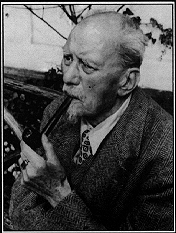
As for his pipe smoking, I have no way to verify it, but I have read on more than one occasion that Crowley liked to smoke straight Perique flavored with rum. The flavoring of tobacco with rum is an old tradition and is not especially remarkable. However, smoking straight Perique may be described to the non-pipe smoker as eating a meal of straight jalapeño peppers and nothing else. Some people can do it, but not many would enjoy it. A thorough description of Perique would require me to write a whole new post, but for now I'll just say that it is created by aging the leaves under pressure and allowing them to ferment in their own juices for a length of time. This creates a very strongly flavored and pungent tobacco. It is normally used as a "spice" tobacco, that is, it is added to blends in small amounts for flavor, the way you might add salt or spices to food.
Crowley, having squandered his inheritance throughout his life, died penniless and addicted to opium of a respiratory infection in 1947.
Wednesday, November 5, 2008
Vintage Ad (1960): Wally Frank
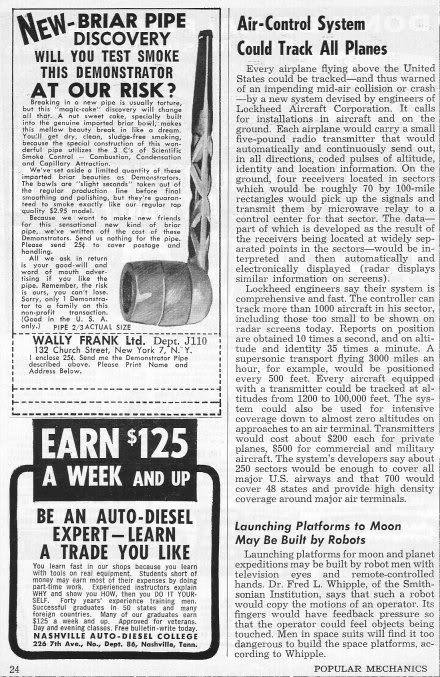
Wally Frank was another pipe maker from the United States that seems to have developed a sort of cult following among collectors of cheaper pipes. Every time I sold one on eBay there was a flurry of bids for it and the final bid always surprised me at how high it went.
Here's one in which they combine at least three different gimmicks:
1. Threaded interchangeable bowl.
2. Pre-caked bowl.
3. Aluminum "radiator" stem.
Not that there's anything wrong with any of these gimmicks, or anything wrong with this particular pipe. However, breaking in a new pipe that has a completely naked inner bowl is not torture. I've always enjoyed it, actually.
Wally Frank also had something going for a while that might get modern nannyists into a frothing fit. They had a "Pipe of the Month Club." Members would receive a brand new Wally Frank pipe in the mail once a month. Of course, several tobacco distributors have had the same kind of program, at one time or another.
I've had a few Wally Franks pass through my hands. They were decent pipes. Nothing spectacular, but fine smokers nonetheless. Every one I had, I eventually resold, mainly because they kept selling so high. I mean, if I pay ten bucks for a box full of old pipes, and the Wally Frank sells for more than I paid for the entire lot, it's hard to not sell it.
Sunday, November 2, 2008
Poll results
Question: What does the tonquin flavor in 1792 Flake smell/taste like to you?
28 Responses:
Chocolate -- 2 (7%)
Vanilla -- 2 (7%)
Chocolate Coffee -- 2 (7%)
Vanilla Coffee -- 2 (7%)
Tonquin, of course! -- 7 (25%)
Chicken -- 0
Blasphemous scents from outside the spectrum of mortal sensation, of which no man may breathe the noisome vapours and still remain wholly sane. -- 11 (39%)
Other -- 2 (7%)
Thanks for playing!
28 Responses:
Chocolate -- 2 (7%)
Vanilla -- 2 (7%)
Chocolate Coffee -- 2 (7%)
Vanilla Coffee -- 2 (7%)
Tonquin, of course! -- 7 (25%)
Chicken -- 0
Blasphemous scents from outside the spectrum of mortal sensation, of which no man may breathe the noisome vapours and still remain wholly sane. -- 11 (39%)
Other -- 2 (7%)
Thanks for playing!
Saturday, November 1, 2008
Featured Pipe Smoker: George Lincoln Rockwell
It may well be impossible to find a neutral account of George Rockwell's life. I will try to stick to the facts as I know them (and even they may be wrong), and avoid editorializing.
Born in Bloomington, Illinois, Rockwell's parents were both vaudevillians and actors. Though brought up as a Christian, he later considered himself an agnostic; still later, he identified himself with the racist "Christian identity" movement. He attended Brown University in Providence, Rhode Island and majored in philosophy. In 1939 he quit school to join the U.S. Navy, since he had come to the conclusion that war with Nazi Germany was unavoidable. He attended flight school and earned his wings in 1940. He served in the Pacific theater and participated in the retaking of Guam.

After the war, he became a commercial artist, opening a photography studio and painting signs. In 1948 he won a $1,000 award for an ad he made for the American Cancer Society. He civilian life was interrupted when he was recalled to active duty at the beginning of the Korean War. He served in California, training Navy and Marine pilots.
Rockwell was married twice but had no children (as far as I can tell).
During his time in California he became an ardent anti-communist and supporter of Joe McCarthy. He also supported Douglas MacArthur's bid for president, adopting the corncob pipe in emulation of the famous photo of MacArthur.
In 1958 he protested the sending of U.S. troops to the Middle East. An admirer sent him an enormous swastika flag, which he turned into the centerpiece of a shrine to Adolf Hitler. He soon became a leader in the American Nazi movement, making white supremacy the focus of his political activism.
 In 1959 he formed the American Nazi Party. He ran the lecture circuit, and was in high demand, lecturing against non-whites, Jews, and communists (he considered Jews to be communists anyway). He formed alliances with the Ku Klux Klan and other supremacist groups. In 1967 he changed the name of the American Nazi Party to the National Socialist White People's Party (apparently completely missing the irony of claiming to be an opponent of communism while simultaneously calling himself a socialist). He was also a holocaust denier (surprise, surprise).
In 1959 he formed the American Nazi Party. He ran the lecture circuit, and was in high demand, lecturing against non-whites, Jews, and communists (he considered Jews to be communists anyway). He formed alliances with the Ku Klux Klan and other supremacist groups. In 1967 he changed the name of the American Nazi Party to the National Socialist White People's Party (apparently completely missing the irony of claiming to be an opponent of communism while simultaneously calling himself a socialist). He was also a holocaust denier (surprise, surprise).Rockwell died of multiple gunshot wounds on August 25, 1967. The man convicted for his murder was one of his own followers whom he had been feuding with, but there is still some debate as to the real identity of his murderer.
Upon being informed of Rockwell's death, his own father is said to have stated, "I am not surprised at all. I’ve expected it for quite some time."
Wednesday, October 29, 2008
Vintage Ad (1944): Kaywoodie Pipes--Raking Leaves
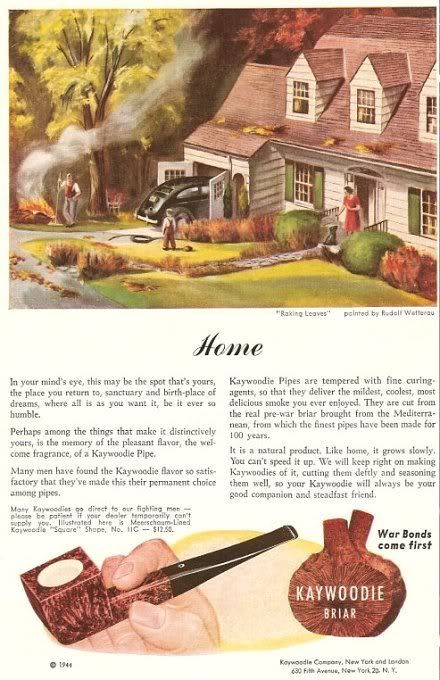
Another Kaywoodie ad from World War II, with art by Rudolf Wetterau that has an autumnal theme. Sentimental thoughts of home in the war year of 1944, depicting the ancient tradition of leaf-burning.
"Many Kaywoodies go direct to our fighting men -- please be patient if your dealer temporarily can't supply you." Orders from soldiers were given priority over those from civilians, and of course, "war bonds come first." Don't buy a pipe if you know you have greater priorities.
Saturday, October 25, 2008
Featured Pipe Smoker: Albert King
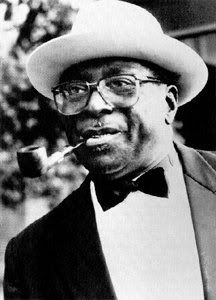
Albert King (1923-1992)
Born into a poor farming family in Indianola, Mississippi, he was one of 13 children, and his real name was Albert Nelson. Perhaps his first musical influence was his own father, who also played guitar. King also sang in a family gospel group as a child, and briefly played drums before settling on the guitar.
Albert King came to also be known as "The Velvet Bulldozer" because of his size (6'4" and 280 pounds). He began guitar on a homemade instrument that he made himself and played the guitar "upside down and backwards" because he was left-handed. Although he later played on a custom-made left-handed instrument, he still strung it in reverse because that's how he was used to playing it. He also developed his own way of tuning the strings, keeping the higher strings "slacked," or not tuned as tightly so the notes they played were somewhat lower. His large, strong hands also allowed him to play dramatic, sweeping bent notes.

In this photo, Albert King demonstrates the advantage of being a pipe-smoking guitarist over being, say, a pipe-smoking saxophonist like Archie Shepp (who will be featured here sometime in the future).
Albert King is one of those musicians whose influence continues to be felt down through the generations, not only in blues, but in R&B and rock as well. Some later guitarists who counted Albert King as one of their biggest influences are Eric Clapton, Jimi Hendrix, and Stevie Ray Vaughan (the last of which will also be featured here sometime in the future).
Albert King died of a heart attack in Memphis, Tennessee in 1992.
Wednesday, October 22, 2008
Vintage Ad (1946): L.H.S. Sterncrest
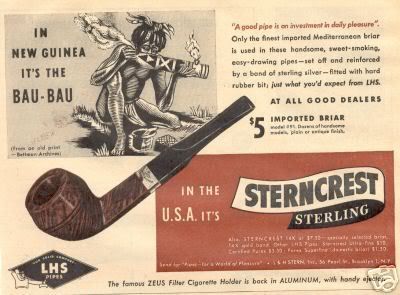
That Bau-Bau is a serious pipe. Kind of makes that Sterncrest look wimpy in comparison.
Saturday, October 18, 2008
Featured Pipe Smoker: Andie MacDowell

Rosalie Anderson "Andie" MacDowell (b. 1958)
Andie MacDowell (imdb link) was born in South Carolina. During her teen years, her mother died, and she worked low-paying restaurant jobs to help support her family.
She attended Winthrop College (now Winthrop University) in South Carolina but dropped out in 1978 to pursue a career in modeling, and became successful as a model for L'Oreal. In 1984 she made her film debut in Greystoke - The Legend of Tarzan, Lord of the Apes (although Wikipedia says her voice was re-recorded by Glenn Close).
The film that pretty much established her as an actress was Sex, Lies, and Videotape in 1989. As of this writing, imdb.com lists her as an actress in 39 films.
She currently resides in Asheville, North Carolina. She is one of the very few famous female pipe smokers who I know of.
It's sometimes difficult to tell if some celebrities actually smoked a pipe off-screen or if the photo I have found is just some movie still or publicity photo "stunt pipe." One indication is to look closely at the pipe. In this picture, it is obvious that there is smoke coming from the pipe. The bowl is still full enough that a tiny bit of what appears to be tobacco leaves--or at least, something--is in the bowl. The end of the stem is in her mouth. She's smoking the pipe.
There are some reports on the internet that at some point she became "a closet cigarette smoker." She enjoyed smoking, but was embarrassed to be "outed." She was born and raised in tobacco country. All these things lead me to believe that yes, she is really smoking the pipe.
I can't ID the pipe, but it is interesting in that it has an unusual square shank and stem.
By the way, for an example of an actor who obviously wasn't a pipe smoker, try to catch the episode of The Dick Van Dyke Show called "The Meerschatz Pipe." First of all, the word is "meerschaum," not "meerschatz." And throughout the entire episode, Maury Amsterdam carried that pipe around like it was a dirty diaper or something. He had obviously never touched one before in his life. It was a wonder he didn't break the thing, the way he was slinging it around by its stem.
Also by the way, "meerschaum" means "sea foam." So I think you can guess what "meerschatz" would mean. (No, it doesn't really mean what it sort of sounds like. It means "sea treasure").
Thursday, October 16, 2008
Smoking the dregs
Yesterday I packed the last of the 1792 Flake into a pipe. There was nothing left. I think this is the first time any tobacco has "come out even" so to speak. I guess I was using just the right pipe.
Today I took out the last dregs of C&D Gray Ghost that I've had sealed up (with the Pump 'n' Seal) for a few months, dumped some Perique into it and mixed it up. This still remains one of my favorite smokes, and it was good to have it again. A few minutes ago I loaded up a pipe with what was left, then topped it off with some Haunted Bookshop that has also had extra Perique added to it.
Why go to this trouble? Ah, so hard to explain. Or perhaps not. I have a few more jars of C&D samples that I know I will smoke but will probably not enjoy so well. My next order will be several pounds in bulk, enough to last me for years. Probably.
But there are tins back in there that I fear to open. They tease me. They taunt me. Escudo, which I've had before and I know I will thoroughly enjoy; so thoroughly that I will probably not smoke anything else after I've opened the tin. And St. James Woods, which has been recommended to me so highly that I'm sure it will be another favorite.
Oh, but I still have several disks of Bullseye Flake that might hold me over for a few days, putting off the inevitable opening of another tin. I managed to stop myself before I had smoked all the Bullseye, but I know once I start again it will be all over.
Planning the next order is sometimes difficult, sometimes not. I've pretty much decided on what to order next time. One pound each of C&D's Bayou Night, Gray Ghost and Exclusive. Two tins of 1792 Flake. Several ounces of Bullseye. Some straight Perique.
My tastes continue to lean more and more toward Virginia and Perique blends, the exception being Gray Ghost which has maduro in it. Lately I've been carrying C&D's Stanhope in the truck.
Stanhope has an on-again-off-again relationship with me. The first time I tried it, I thought it was one of the best things I'd ever smoked. The second sample, a year or two later, didn't thrill me so much. This latest sample is somewhere in between. It seems to have almost a velvety texture this time, and the latakia is now quite noticeable. I've steered away from latakia since I developed such a love for Perique, and it seems I've developed a sensitivity to it. Where I once loved all I could get, I now think that most latakia blends have too much and would be improved with less.
And I do miss having Bayou Night. It still remains my favorite smoke, anytime of the day or night. But unfortunately, if I have it on hand I tend to reach for it over anything else, and it doesn't last long.
What's the point of this post? No point. Just some rambling thoughts on pipe tobacco.
Today I took out the last dregs of C&D Gray Ghost that I've had sealed up (with the Pump 'n' Seal) for a few months, dumped some Perique into it and mixed it up. This still remains one of my favorite smokes, and it was good to have it again. A few minutes ago I loaded up a pipe with what was left, then topped it off with some Haunted Bookshop that has also had extra Perique added to it.
Why go to this trouble? Ah, so hard to explain. Or perhaps not. I have a few more jars of C&D samples that I know I will smoke but will probably not enjoy so well. My next order will be several pounds in bulk, enough to last me for years. Probably.
But there are tins back in there that I fear to open. They tease me. They taunt me. Escudo, which I've had before and I know I will thoroughly enjoy; so thoroughly that I will probably not smoke anything else after I've opened the tin. And St. James Woods, which has been recommended to me so highly that I'm sure it will be another favorite.
Oh, but I still have several disks of Bullseye Flake that might hold me over for a few days, putting off the inevitable opening of another tin. I managed to stop myself before I had smoked all the Bullseye, but I know once I start again it will be all over.
Planning the next order is sometimes difficult, sometimes not. I've pretty much decided on what to order next time. One pound each of C&D's Bayou Night, Gray Ghost and Exclusive. Two tins of 1792 Flake. Several ounces of Bullseye. Some straight Perique.
My tastes continue to lean more and more toward Virginia and Perique blends, the exception being Gray Ghost which has maduro in it. Lately I've been carrying C&D's Stanhope in the truck.
Stanhope has an on-again-off-again relationship with me. The first time I tried it, I thought it was one of the best things I'd ever smoked. The second sample, a year or two later, didn't thrill me so much. This latest sample is somewhere in between. It seems to have almost a velvety texture this time, and the latakia is now quite noticeable. I've steered away from latakia since I developed such a love for Perique, and it seems I've developed a sensitivity to it. Where I once loved all I could get, I now think that most latakia blends have too much and would be improved with less.
And I do miss having Bayou Night. It still remains my favorite smoke, anytime of the day or night. But unfortunately, if I have it on hand I tend to reach for it over anything else, and it doesn't last long.
What's the point of this post? No point. Just some rambling thoughts on pipe tobacco.
Wednesday, October 15, 2008
Injun Summer
Date unknown, but from an old issue of the New York Daily News Sunday edition, according to Sad Old Goth.
 Click to enlarge for a more readable version.
Click to enlarge for a more readable version.
(Not an ad, but I'll put it in that category anyway to keep things simple).
 Click to enlarge for a more readable version.
Click to enlarge for a more readable version.(Not an ad, but I'll put it in that category anyway to keep things simple).
Tuesday, October 14, 2008
Vintage Ad (1947): Yello-Bole Pipes

The Yello-Bole, one of the more famous gimmick pipes, which may take some explanation for non-pipe smokers.
All pipe smokers (pretty much) are concerned about cake. Cake is the build-up that occurs inside a pipe bowl as it is smoked. A pipe with just the right amount of cake generally smokes better, cooler, and drier than a new, uncaked pipe. Some newbie pipe smokers get kind of worried when they don't see cake building up right away, and there are all kinds of tricks to speed cake build up. One of these tricks is to get a little drop of honey on your finger and swipe the inside of a new pipe with it to get the ash to stick better. This provides a sort of foundation for cake build up. This isn't because honey somehow has some kind of magical properties when it comes to pipes, it's simply because it's sticky, and being edible, there are no harmful fumes if it gets toasted a little. The same effect can be had by using a drop of saliva.
Almost every pipe company that has ever been has had what is called a "seconds" line. Seconds are pipes that, for one reason or the other, didn't quite measure up to the standard of the company to earn the company's actual brand name. It's just about impossible to know if any given burl of briar is going to be flawless; most aren't. Some are more flawed than others. But still, buying briar costs money, and labor had to go into the making of a pipe, so they don't want to just throw away a pipe because there might be a tiny sandpit or two in the briar. For example, Peterson pipes sell their seconds under the name "Irish Seconds." These are pipes that are still perfectly good smokers, they're just not quite perfect enough to warrant the name "Peterson." Everybody knows Irish Seconds are actually cast-off Petersons and that they are, in general, still very good pipes.
The brand known as Yello-Bole is actually Kaywoodie's seconds line. Since Kaywoodie already had several grades for their pipes, a pipe that didn't live up to the Kaywoodie name must have been pretty far down the ladder.
Kaywoodie went one better on their seconds, and not only did they call them by a different name, but they came up with a whole new gimmick to sell them. The inside of the bowl is coated with "honey."
I say "honey" in quotations because, of course, it isn't real honey. Honey may be one ingredient, but it's still a dry, yellow substance instead of a liquid, golden-brown substance. They claimed that it made them smoke cooler, better, so forth and so on, like all gimmicks are supposed to do when it comes to pipes. After a few bowls, the yellow stuff would be all gone, and you would still have to build up a normal cake anyway.
Finding a Yello-Bole these days that still has the original yellow cake intact is probably very uncommon. In my used-pipe buying days I found one that someone must have broken out of the package, tossed in his desk drawer, and never looked at again. It had several bids, and sold for probably 4 or 5 times what it originally cost back in the 1950s.
The one in the ad above even looks like a Kaywoodie, with a screw-in stem and the logo right where the Kaywoodie cloverleaf would be on the stem. The Yello-Bole logo was a golden circle.
My own attitude toward cake has always been somewhat relaxed. It just happens. Depending on a pipe smoker's frequency of using any given pipe, the tobacco used in it, and even the pipe itself, cake will happen sooner or later. It's always going to happen eventually, so don't get too worked up about it if it doesn't come along as soon as you think it should. Eventually, you will be breaking out your pipe tool and reaming a little cake out of it because it's getting too thick. So just enjoy your pipes and don't worry about the cake.
Sunday, October 12, 2008
The Poll on the left
In the left sidebar is a quick & dirty poll that I put together with Blogger's new(ish) "create your own poll" gadget. As you can see from the available choices it is somewhat tongue-in-cheek. If your choice is "other," please leave a comment trying to describe what it does taste like to you, and later on I'll put all the descriptions together in one post.
Saturday, October 11, 2008
Featured Pipe Smoker: "Old" Tom Morris
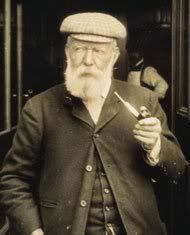
Old Tom Morris (1821-1908)
Tom Morris, Sr., (pictured here in 1896) better known as Old Tom Morris, was born in St. Andrews, Scotland. He started his career in golf apprenticed to "featherie" ball maker Allan Robertson (Robertson is known as the world's first golf professional). When new ball technology made the featherie obsolete, Robertson opposed the new ball. Morris simply went his own way and began making his own balls. He was also a club maker, course designer, and champion golfer.
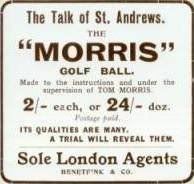
Morris won four Open Championships during the 1860's, and is the oldest person ever to win the Open Championship, at age 46. He was Keeper of the Greens at Prestwick from 1851 to 1864, and Custodian of the Links at St. Andrews for nearly 40 years, until he retired in 1902.
Some of the courses he designed are Prestwick, Royal Dornoch, Muirfield, Carnoustie, Royal County Down, Nairn and Cruden Bay. His fee was £1 per day plus expenses. He standardized the golf course at 18 holes, introduced the idea of placing hazards so the ball could be routed around them (previously they were just there and you had to deal with it), and introduced the course design concept of each nine holes returning to the clubhouse.
Old Tom passed away in 1908, a few months after sustaining a fractured skull from falling down the stairs at the clubhouse.
Subscribe to:
Posts (Atom)

